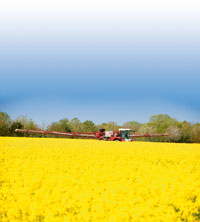Latest oilseed rape seed treatments look promising

Launched last year, the oilseed rape seed treatments Modesto and Cruiser OSR promised better pest and disease control. Did they deliver, asks Louise Impey?
There are subtle differences between Cruiser OSR and Modesto, agree most experts, but both products performed very well in the field in their first commercial year.
Twelve months on, the role of these second generation neonicotinoids in controlling autumn aphids and limiting the spread of turnip yellows virus has been confirmed, following high aphid pressure last autumn, reports Mark Stevens of Broom’s Barn.
“Research work has shown that around 30% of Myzus persicae aphids are carrying the virus,” he says. “The value of these seed treatment is in stopping secondary spread of the virus, as the aphids have to feed to pick up the chemical. They don’t stop infection completely.”
Both treatments offer around eight weeks protection against the virus transmitting aphids, he explains. “Autumn is a critical period, as that’s when the aphids migrate into crops. In a mild autumn, that might be from the end of August until Christmas.”
However, with a prolonged migration, it’s unrealistic to expect the new seed treatments to have enough fire power, he warns. “You’ll have to spray as well, which is where there can be difficulties. You can’t use a neonicotinoid-based insecticide, so despite some 20% of aphids carrying kdr resistance, a pyrethroid is probably the best bet.”
Whether the aphid-control properties of seed treatments will be important this autumn remains to be seen, admits Dr Stevens. “We’re seeing the benefit of a cold winter on aphid numbers. It’s been very difficult to find a single Myzus persicae so far.”
But pest control is only part of the picture with Modesto and Cruiser OSR, as control of early establishment diseases is also claimed. Modesto has to be co-applied with Hy-Pro Duet to add disease control to its portfolio, but Cruiser OSR is ready formulated to include fludioxinil and metalaxyl-M.
ADAS trials suggest that Cruiser OSR gives faster establishment and reduced levels of early phoma. Peter Gladders, a plant pathologist at ADAS confirms that the vigour effects from Cruiser OSR were striking.
“It could be important in more marginal farm conditions or where the phoma threat occurs soon after sowing, before foliar sprays can be effective. But that hasn’t happened yet to give them a proper test – only a wet August will give us an early epidemic,” says Dr Gladders.
Independent agronomist Peter Taylor says it is very difficult to pull the two new seed treatments apart, although he does favour Cruiser OSR in a bad downy mildew year. “The difficulty for growers is that they have to order their seed before they know what conditions will be like.”
Case Study: Phil Smith, Aberdeenshire
Getting things right in the first month is critical to oilseed rape performance in Aberdeenshire, with early establishment playing a key role, says Ellon-based grower and agronomist Phil Smith.
For this reason, the introduction of the next generation seed treatments has been a real boost, as their contribution to plant vigour has helped him guarantee the ground cover required to survive the winter.
“Our aim is to plant the crop in good time, get it away fast and protect it from slugs,” he reports. “Drilling date is critical, as everything has to be in the ground by the end of August. The next deadline is to make sure that it’s reached the first true leaf stage by four weeks after drilling.”
Two years experience has convinced him of the merits of Cruiser OSR and Modesto. “Compared with Chinook-treated crops, plants are through the ground two days faster. After eight weeks, they have a couple of extra leaves.”
This guarantees him optimum ground cover, as well as plants which are big enough to withstand pigeons.
Last year, Mr Smith conducted strip trials on his farm at Cairnadailly, comparing seed treatment performance. One month after drilling, Cruiser-treated plants just had the edge, being a day ahead of those treated with Modesto and two to three days in front of Chinook.
“We also saw lower levels of downy mildew with Cruiser, with treated crops being half a leaf ahead by the end of the autumn.”
Despite this, he won’t be using the new seed treatments to extend the drilling window. “We can’t risk waiting until September or having florets forming before Christmas. Time isn’t on our side.”
His preference would be to use one of the seed treatments on varieties with good resistance to light leaf spot and club root, allowing him to have disease and pest control covered at drilling. “That would just leave an application of pre-emergence metazachlor, before we can shut the gate on the crop for the winter.”

